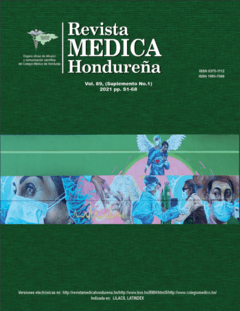Giant cell glioblastoma: case report.
DOI:
https://doi.org/10.5377/rmh.v89iSupl.1.11893Keywords:
Cerebellum, Glioblastoma, Glial Fibrillary Acidic Protein, Honduras, Neoplasms, Second PrimaryAbstract
Background: Glioblastoma (GB) or grade IV astrocytoma, is an aggressive tumor that originates from glial cells, with a high-grade of malignancy, prevalence of less than 1% in the posterior fossa and incidence of less than 0.5% of all GB. There are currently about 75 cases described worldwide. Clinical case description: 24-year-old female, referred to HEU´s Neurosurgical emergency, presented intense holocrine headache, vomiting, nausea, blurred vision, vertigo, and anorexia. The neurological examination showed discrete right adiadokinesia and signs of papilledema. Brain CT showed heterogeneous lesion in vermis extended to right cerebellar hemisphere, therefore, suboccipital craniectomy with a transcerebellar approach, was perfomed, leading to tumor cytoreduction, finding vascularized mass with cystic component. Anatomopathological study showed glioblastoma multiforme variant of giant cells, confirmed with immunohistochemical staining (GFAP, CD34+ and vimentin). Patient with good post-surgical clinical evolution, is discharged without neurological deficit. At 16 months later she presents tumor recurrence syndrome and complications, was re-intervened on four occasions, after receiving 30 doses of radiotherapy and 12 cycles of chemotherapy. She was readmitted with progressive neurological deterioration, meningeal signs and 30-point of Karnofsky scale and Parinaud’s syndrome and underwent PVS by IV ventricular compression and secondary obstructive hydrocephalus, performing ventricle-peritoneal shunt by compression of the IV ventricle and secondary obstructive hydrocephalus, then he developed intrahospital pneumonia, dying after two weeks. Conclusions: It’s important to identify the biological variant of glioblastoma early, to determine prognosis, therapeutic actions that will influence quality of life, as well as survival.
Downloads
540




